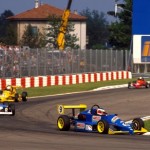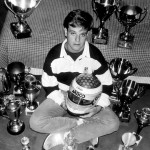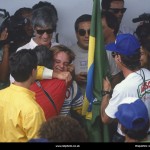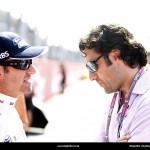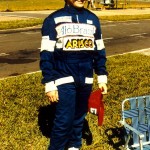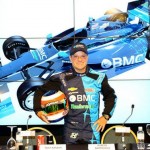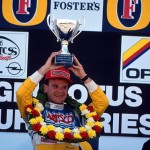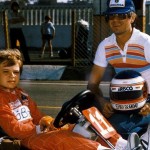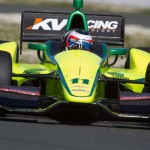Rubens Barrichello: Born to race
KV Racing and the Izod Indycar’s series gain is huge. Formula 1 has called time on a brilliant servant, a guy that had F1 on his mind practically since the day he was born.
The news that Rubens Barrichello’s 19-year Grand Prix career is over – for now – made me leap back to February 1990, and Pisa airport. His new team, Draco Racing flew him to Europe. He hardly spoke any English, was very shy, I was the first European journalist to interview him (through a translator). Even then, there was ‘something’ about him. When we talked, his experience was limited to 11 Formula Ford races after eight years of karting in Brazil (and six titles).
By the end of that year, his English had improved vastly, and so had his resumé, which by then also included “Opel Lotus Euroseries Champion”. Among his rivals that year were David Coulthard, Gil de Ferran, and plenty of other future racing stars. Here are some excerpts from my end of season interview with him in 1990, interspersed with memories from today.
(And while he laughed at it, he didn’t like my 1990 introduction!)
Hello Barrichello
Autosport, November 29, 1990 by Andy Hallbery
Rubens Barrichello is an unlikely looking racing driver. He is short, slightly tubby, and still wears a brace on his teeth. But you can’t argue with his record. He is 18 years-old, has just become the GM Lotus Euroseries champion, will join West Surrey Racing for British F3 in 1991, and he has a sponsor committed to taking him all the way to Formula 1. And he’s Brazilian.
“The Draco team is important to me,” he said. “I can speak my own language. It’s like my European family.”
Draco’s Adriano Morini was keen to get Rubens in his car. “It was a natural choice for us,” said the Italian team owner. “We thought with so little experience, he would need two seasons.”
Rubens moved from Brazil – he was born and lived on the outside of Turn 3 and Interlagos, so racing was already in his blood – to Italy, and then to England a month later – first to Attleborough, five miles from Snetterton, previously home to Ayrton Senna, Maurico Gugelmin and many more Brazilians on a mission to F1, and then to Cambridge. “It was good for me to come to England, and I quickly learned the language. English is not too difficult to learn,” Rubens said.
Barrichello had two trademark moves that 1990 season. He would usually take pole position, then he would waste it with a rubbish start! The opposite was David Coulthard. Who often qualified badly, but made lightning starts. It was a trend that continued through F3 and F3000, and even F1. DC treats Rubens as a career long rival.
Rubens laughs at the memories of those EFDA Opel Lotus days.
“Yes I loved the qualifying. I love the perfect lap, that one lap when you are concentrating so hard,” he says.
“When we supported Formula 1 I would always watch Senna’s qualifying lap, I would go and sit and concentrate, then go and make my time. We were limited on tyres, so it was a bit like F1. All your effort goes into those laps.”
Remember that this was Rubens speaking in 1990, three years before his own F1 debut.
Senna was a fan and a supporter as young Rubens moved on up. Even if you don’t speak Portuguese the body language says it all. Ayrton respected Rubens, even as an 18 year-old.
If he had qualifying down to a fine art, Rubens still admits he wasn’t so good at the start… “Ha! Yes! I hadn’t learned the start then. In testing we did many starts… It was my problem, and I had to learn.”
Still only 18, and winning a lot in front of the F1 teams, the F1 rumour mill went into overload. Minardi supposedly wanted to sign him there and then. Arrows too were keen. But the lad kept his feet on the ground. “The paddock was open. I could go to Minardi or Arrows in the F1 paddock and talk about my problems,” he recalls. “That was the best thing about the EFDA Opel Lotus Euroseries – the paddock was open for us young guys.”
Also of help was that his sponsor Arisco, a Brazilian foodstuffs company that had been with him since his karting days, committed to taking him all the way to F1 – a luxury few of his rivals had. That was one less thing to worry about. A five-year plan if you like.
“I think two years in F3, two years in F3000 and then – I hope – F1,” he said in 1990. “I want to get to Formula 1 the right way. Not too quick, not too slow, but the right way. Then I can arrive in Formula 1 with much experience.”
Well, he scrapped that plan… One year of F3 followed (British champion), a year in F3000 next (third overall), and by 1993 he was a Grand Prix driver for Jordan. He came oh so close to a podium finish in only his third F1 race at Donington.
Now, 19 years later, and 322 F1 starts on, he embarks on a new career to step into Indycars where the charming Brazilian – 11 time Grand Prix winner, 14 pole positions – will earn a load of new fans. He is the most popular F1 driver on twitter with almost 1.5million followers, which in itself says a lot.
Maybe he is so popular as he wears his heart on his sleeve? He often had to give way to his teammate, yet who didn’t join in the emotion of his win at Hockenheim?
Rubens also has the memory of an elephant. He will always say hello to me (and many others he has not seen for years), followed very soon after with: “Where’s my half of the money?!” A reference to a bet I placed on him to get a podium finish with Stewart at the European Grand Prix in 1999 where he finished second. Eddie Jordan taught him well… But I still have the money!
Indycar people, look forward to some fun with RB, one of the nicest drivers I have ever worked with.
Special thanks to Rubens Barrichello, and follow him on twitter @rubarrichello
Images: Thanks to www.Sutton-Images.com , where you can buy prints not only of the above, but more. Other photos by LAT, http://www.latphoto.co.uk/ who also produce prints from a massive archive. And KV Racing Technology
By Andy Hallbery follow me on twitter @Hallbean
Follow @MotorSportRetro on twitter Like us on Facebook





